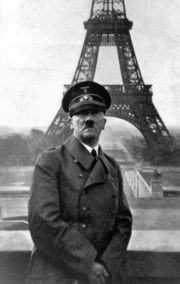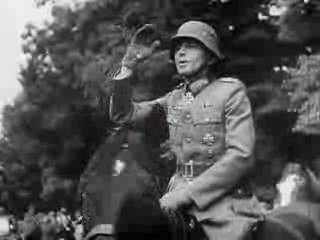
 To
order Hitler Sites ($55)
click here
To
order Hitler Sites ($55)
click here
After the
German Army had overrun France in June 1940, the
victorious Hitler, along with architect Albert Speer, sculptor Arno Breker,
architect Hermann Giesler, and others proceeded to Paris, landing at Le Bourget
at 5:30 in the morning. Three Mercedes sedans were waiting. Hitler sat as usual
in the front seat, beside the driver.
The first stop was the Opera, Charles Garnier’s
neo-baroque masterpiece.
The tour continued past the Madeleine, down the Champs Elysées, and on to the
Trocadero, where there was another stop. Hitler posed for a famous photograph in
front of the stone balustrade, overlooking the Seine and the Eiffel Tower. From
the Arc de Triomphe, with its tomb of the unknown soldier, the party drove on to
les Invalides, where Hitler stood for a considerable time gazing down at the
tomb of Napoleon.
The proportions of the Pantheon (110 meters long, 84 meters wide and 83 meters
high) greatly impressed Hitler. But other classic architectural splendors left
him cold: the Places des Vosges, the Louvre, the Palace of Justice, and the
Sainte-Chapelle with its exquisite stained glass windows.
Hitler became enthusiastic again only when he visited the Rue de Rivoli. So
delighted was he with this street that the German Army requisitioned part of it
for their military governor of Paris, whom they installed in the Hotel Meurice
(no. 228).
The three-hour tour ended with a visit to the church of Sacré Coeur on
Montmartre. Surrounded by several powerful bodyguards, Hitler stood for a long
time appreciating this domed building. His admiration was surprising, given his
taste and the fact that Sacré Coeur had been constructed just after the Germans
had soundly thrashed the French in 1870, as a symbol of French confidence in the
beleaguered country’s future.
By nine in the morning, the sightseeing was finished. “It was the dream of my
life to be permitted to see Paris,” Hitler told Speer. “I cannot say how happy I
am to have that dream fulfilled today.”
A few hours later, Hitler spoke to Speer in the Führer field headquarters, a small room of
a peasant
house in Brûly de Pesche. “Draw up a decree in my name ordering full-scale
resumption of work on the Berlin buildings...Wasn’t Paris beautiful? But Berlin
must be made far more beautiful. In the past I often considered whether we would
have to destroy Paris. But when we are finished in Berlin, Paris will only be a
shadow. So why should we destroy it?” Hitler spoke with great calm, Speer
remembered, as though the monstrous vandalism he contemplated was the most
natural thing in the world.
 Video: Hitler in Paris and German victory parade:
Launch
Windows Media Player
Video: Hitler in Paris and German victory parade:
Launch
Windows Media Player
Hitler visits the Madeleine, Opera, Place de la Concorde, Arch of
Triumph, and Trocadero. German soldiers visit French grave of the unknown
soldier at the Arch of
Triumph. Lieutenant General Kurt von Briesen awards first class iron crosses to
his troops, the 30th infantry division.
Von Briesen, on horseback, salutes his
men as they parade along Avenue
Foch. Von Briesen was promoted to General on August 1, 1940. Soviet aircraft killed
him,
age 55, in Russia, Isjum on the Donetz, southeast of Kharkov, 12:30pm, November
20, 1941.



